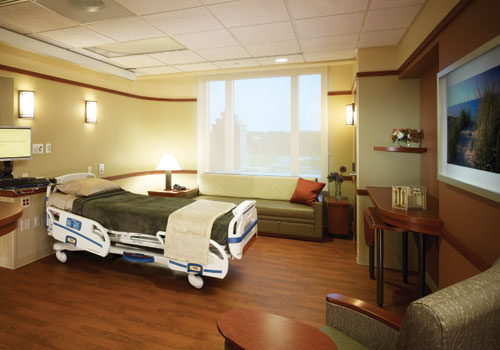Functional Color and Design in Healthcare Environments
In Medieval times, the study of medicine was prohibited as religious leaders restricted the growth of science. Human life spans declined until advances in printing led to scientific collaboration and the Renaissance. The 16th and 17th centuries brought about the creation and development of the microscope, opening up new worlds of medical exploration and equipment including the first mercury thermometer. By the 18th century, the life span of the average person increased to 50 years of age as a variety of illnesses began to be diagnosed and treated with medicine, confinement and care.
Women became active healthcare participants in the 19th century. In Florence Nightingale's preface to her book on hospitals, she wrote, “It may seem a strange principle to enunciate as the very first requirement in a hospital that it should do the sick no harm.”1 She began the first nursing school in 1860 that led to the reform of hospital environments.
The 20th century brought organ transplants, healthcare plans and a life expectancy of 77 years. The 21st century has seen the first implantable artificial heart, stem cell research and an anticipated life span of 90 to 100 years of age. In this period there has been continued research and understanding of the impact of the environment on healing and healthcare outcomes.
GROWTH OF EVIDENCE-BASED DESIGN
In the last quarter of the 20th century, researchers began to explore design concepts that might improve healthcare facilities. In the 1990s, the Center for Health Design, a non-profit organization, was committed to advancing design in healthcare settings to improve patient outcomes. They launched the Pebble Project in 2000 to encourage the adoption of stricter research methodology, data collection and collaboration for healthcare designers. Evidence-based design (EBD) practitioners employ credible data and research to influence design decisions. The Pebble Project was created as a way to engage healthcare designers who were building or renovating environments to document their results and meet frequently with each other. The goal of the project was to create a cascade of insights on healthcare environments that would have a beneficial ripple effect throughout the industry. The research from the Pebble Project gained even more momentum as in tandem with its acceptance and growth, mind-body medical science was developing rapidly and confirming that patient stress and emotional states affect clinical outcomes. The Center for Health Design is the primary source for certification in evidence-based design and those professionals who have passed this exam list EDAC after their names as qualified providers of EBD design planning.
 |
Designed by Albert Kahn Associates, Inc., this patient room in Elmhurst Memorial Hospital demonstrates how the use of natural colors and materials along with views to the outdoors can create an enhanced atmosphere for healing. Photo by Scott McDonald |
Hospitals built in the mid-20th century were functionally efficient yet blind to the emotional needs of the patient. One of the most cited and influential evidence-based healthcare design researchers in the world is Roger S. Ulrich, PhD, professor of architecture and landscape architecture and faculty fellow for the Center for Health Systems and Design, Colleges of Architecture and Medicine, Texas A and M University. His 1984 study, published by Science magazine titled “View Through A Window May Influence Recovery from Surgery”2 discussed the emotional needs of patients and the influence of design on patient safety and health.
His studies are lauded for their scientific rigor, and his findings continue to be readily implemented by healthcare managers, clinicians, architects and policy makers throughout the world. His research has influenced the design of many billions of dollars of hospital construction and improved the safety and health outcomes of patients across the globe. Because of his work in this field, we are learning that designing within the basic principles of nature can lead to positive outcomes. It is becoming clear that evidence-based design is an approach to design that improve outcomes for the patient, family and staff within the healthcare facilities.









